The Total Television Guerrillas Who Upturned Conventions
By Peter Monaghan
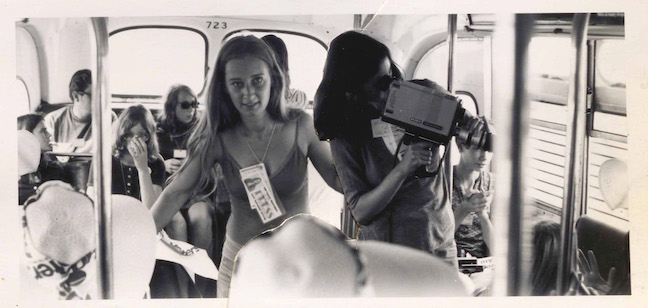
Jody Sibert (left) and Wendy Appel (with camera) interview a busload of Young Republicans at the 1972 Republican National Convention. All images: ©TVTV; courtesy Berkeley Art Museum and Pacific Film Archive.
There once was a time when cellphones didn’t capture just about everything that happens in public.
Try explaining that to your kids.
Until the 1970s, filming for broadcast was generally constrained, for starters, by the size and weight of cameras. Today, even cheap cellphones may have impressive cameras and microphones, but until that time, TV cameras and their tape setups, shackled to power sources, were the size of half a car.
Back then, the three major television networks in the United States had limited access to mammoth events such as political party conventions. Due to the relative immobility of the devices they used, they had to transact access with party publicity machines. They, and their viewers, largely got to see what the parties wanted them to see.
Naturally, that ensured a high degree of control over political messaging.
Then along came “guerrilla tv,” where media activists used portable, lower-end technology and went wherever they could get away with going. “In the ’70s that was really new; it hadn’t been possible before,” says Michael Campos-Quinn, the director of library special projects at the Film Library and Study Center at the University of California at Berkeley’s Berkeley Art Museum and Pacific Film Archive (BAMPFA).
BAMPFA has just inaugurated a new online exhibition, Guerrilla TV, depicting the daring novelty of what the pioneers of that movement — in particular, the San Francisco collective, Top Value Television, or TVTV — did and depicted when they let loose on unsuspecting party-convention delegates, and even turned the cameras onto the media companies that covered them.
wandering new-form news crew
TVTV’s groundbreaking chroniclers wandered among the delegates and the network and newspaper journalists covering them, and confronted them with frank questions. That broke with convention. Newscameramen were expected to adhere to expectations about where they would position themselves, and consequently, what they would film, and what reporters would cover.
That’s to say, newsmen — and they were virtually all men — were expected to mind their place, to take “the news” as it was presented to them by party officials even while purporting to provide viewers with faithful reportage about events that would greatly affect those viewers.
Guerilla TV pioneers operated another way: when they went to the national Democratic and Republican political conventions of 1972, their first major theaters of operation, they threw out the playbook followed by the television networks, and instead sought to provide a round-the-clock insider’s view. They did that by presuming to, and achieving, far greater access than most television reporters. Frequently they got away with that approach because what they were doing was so outside their subjects’ expectations. As Campos-Quinn says: “Politicians weren’t used to people being able to get in their face and record everything.”
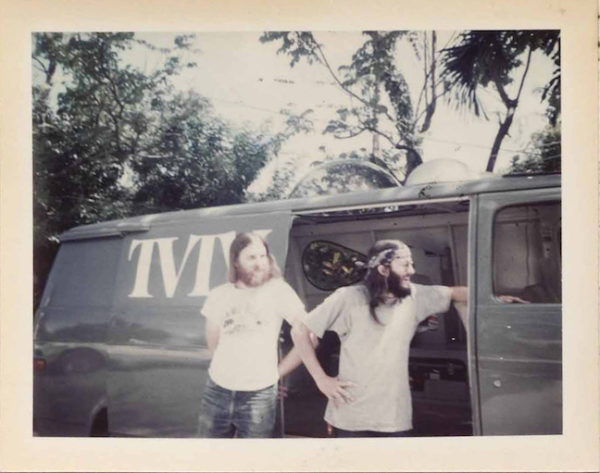
Hudson Marquez (left) and Chip Lord pose in front of the TVTV media van.
a new online exhibition
BAMPFA has been working on its new interpretive website since 2018. The focus particularly on a group with San Francisco Bay Area roots, Top Value Television (TVTV), is easily explained. It was based in the San Francisco Bay Area and it was, as BAMPFA credibly characterizes it, “a major force in the counterculture movement of the 1970s.”
BAMPFA has undertaken its project, Saving Top Value Television: Alternative Documentation of American Cultural History and Politics, with funding for digitization and preservation from the federal National Endowment for the Humanities. The grant of a little more than $220,000 has allowed BAMPFA to digitize almost 450 camera-original tapes, working with MediaPreserve, a Pennsylvania-based digitization specialist. BAMPFA has also digitized thousands of pages of archival paperwork, press clippings, scrapbooks, and other Top Value Television ephemera, working with Backstage Library Works of Provo, Utah.
The Top Value Television — TVTV — collective of artists and activists became widely known “for its provocative and irreverent public access broadcasts” depicting the political ferment of the ’70s, as BAMPFA’s description puts it.
TVTV formed in 1972 at a time when portable cameras — the smallest of them destined for the consumer market — were becoming more widely available and more affordable after first coming to the market in the mid-1960s.
Such collectives were popping up around the country. Many were intent on portraying local community events. Some were experimenting with video’s possibilities in experimental filmmaking and other visual art. Many adherents of both those approaches —popularly dubbed “video freaks” — came to the San Francisco area and coalesced around creating new media forms and fresh products that told it like it was.
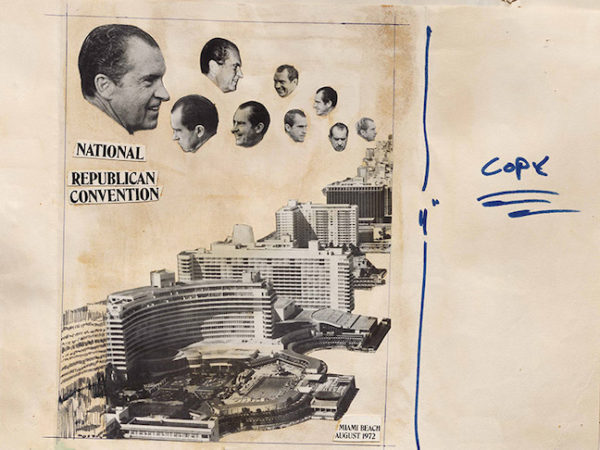
From TVTV’s scrapbook made during the 1972 Republican National Convention.
TVTV’s founders and participants planned alternative approaches not only to network television, but even to public-access broadcasting of the kind that focused on community social-reform events and efforts. They steered more towards the spirit of the “gonzo journalism” of Hunter S. Thompson and Tom Wolfe.
That meant reporting in real time, both capturing and becoming part of the social upheaval of the era — the Democratic and Republican national conventions of 1972 provided TVTV with an ideal test bed for its approach, but their incursions, although sometimes shambolic, were far from haphazard.
the theory behind the disruption
As curator Steve Seid explains in an introductory essay to the BAMPFA interactive website, TVTV’s adherents were inspired as much by the Bay Area experimental art scene — the use of video in film and visual art — as by gonzo journalism. The self-proclaimed “video freaks” or “freex” brought a radical first-person perspective to news reporting.
Seid writes that a “harmonic convergence” took place in 1969 around a landmark video exhibition at the Howard Wise Gallery in Manhattan, New York, called TV as a Creative Medium. It advocated just what its title said. It was, Seid recalls, a provocative exercise, coming at a time when “television was the ‘vast wasteland,’ not a playpen of possibility.” The idiot box was not just pallid and ill, but downright dangerous: “Television was the corporate invasion of America’s living rooms.”
The exhibition sprang, Seid writes, from “the aggregate of a mindset, years in the making, which saw the utopian approach of a limitless media ecology that would unite man and machine.”
If that sounds rather abstract, it’s because it is, even though it had very concrete outcomes. The utopianism, Seid explains, was that of media theorists like Marshall McLuhan — “the medium is the message,” and so forth. McLuhan may be the best known media provocateur of his day, but there were plenty of others: Norbert Weiner, Buckminster Fuller, Gregory Bateson, who “wed cybernetics and communications theory to psychopharmacology, radical social organization, and spirituality for a heady brew that promised techno-transcendence.”
A heady mix. The Portapak seemed to provide a device for scaling the battlements of corporate media domination.
The TV as a Creative Medium exhibition, Seid says, represented the visual-art angle on media intervention; its participants were “artists who were futurists, techno-scavengers, and advocates for the subversion of mainstream media.” Meanwhile, news iconoclasts were joining the revolution, too. One was Michael Shamberg, who was on assignment for Time magazine when he first took an interest in the emerging fresh uses of visual media.
With others, he formed Raindance Corporation, a precursor to TVTV and a sort of countercultural think-tank that published 11 issues of a decidedly forward-looking periodical, Radical Software. He also wrote his own book, Guerrilla Television, speculating — specifying, even — how the new approaches to media, along with technologies then emerging, would free the people from the “psychic genocide” of “beast-TV.”
Rather than be mauled and devoured by the beast, the people were going to rise up and make their own media, he professed. He gave extensive advice on how anyone who was sufficiently alive to the task could advance that cause. (Another collective, Videofreex, would publish a similar manifesto-manual, The Spaghetti City Video Manual, two years later.)
All it would take would be a Portapak and nerve to deliver comeuppance.
Seid describes Shamberg’s thinking on how this would be done as a matter less of assault and affront than of canny positioning: “This was not to be a take-no-prisoners undertaking — guerrilla television was, after all, nonviolent by definition — but a subversive, parallel-universe of alternative media construction.”
two unconventionally reported conventions
The Democratic and Republican national conventions of 1972 provided TVTV with an ideal test bed for its approach. Both events took place in Miami, Florida. As they approached, 26 collective members traveled by bus to that faraway city, rented a house as their base of operations, and set about depicting the conventions as never before. The results were two celebrated, even infamous one-hour documentaries, The World’s Largest TV Studio, a documentary report about the Democratic National Convention, and Four More Years, about the Republican National Convention that followed only two weeks later in the same Miami convention center.
It was a race in which the progressive Democratic rival, George McGovern, was pitted against the fear-mongering, ultimately successful Republican candidate Richard Nixon, and lost in one of the largest electoral landslides in American history.
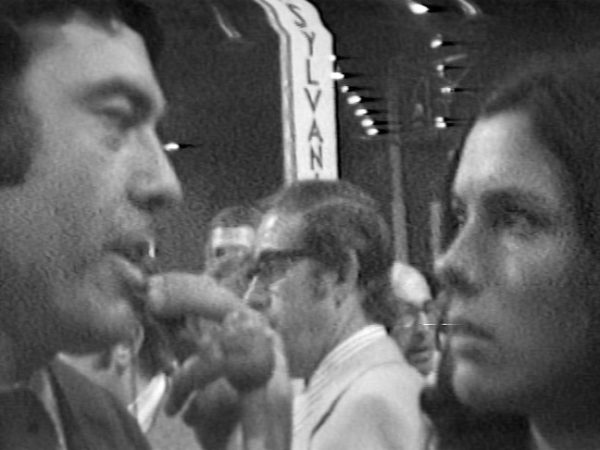
TVTV’s Maureen Orth interviews Dan Rather (left) on the floor of the 1972 Democratic National Convention.
So fraught a contest called for drastically new approaches. Sony Portapaks provided one. The easily operated, battery-powered videotape analog recorders cost a manageable $1,500, and crucially were portable. (They were still quite heavy, by today’s standards, weighing in at 7 pounds with a 25-pound battery.) That allowed TVTV’s guerrillas to wander almost unimpeded behind traditional media lines, to get to the politicos, lobbyists, pundits, and hangers-on and present the Democratic and Republican conventions in all their carnivalesque oddness. (Among other documentary films they made was four-part Gerald Ford’s America, about the 100 days following Nixon’s disgraced resignation, plus ones about the Super Bowl and the Oscars.)
During the convention films, viewers are treated to police launching teargas but the footage they captured surely made it all worth the filmmakers’ inconvenience. Their convention documentaries included appearances by figures famous then or later, including news anchors Walter Cronkite and Dan Rather and activists Ron Dellums, Ralph Nader, and Gloria Steinem.
Steinem featured in a press conference held by the National Women’s Political Caucus at the Democratic convention. Along with her were fellow leading feminists Bella Abzug, Frances “Sissy” Farenthold, and Betty Friedan, and they engaged in discussion with two future founders, in 1973, of the National Black Feminist Organization, Florynce Kennedy and Margaret Sloan-Hunter, who charged “second-wave feminism” with ignoring the concerns of Black and lesbian women.
John Lewis, then executive director of the Voter Education Project, at the beginning of a long, illustrious political career, was interviewed, and he lamented that so many young people had been swayed to support an “out of date and obsolete” Republican party.
The World’s Largest TV Studio also depicted successful efforts by supporters of George McGovern — among them a young Jesse Jackson — to remove contentious Chicago mayor Richard J. Daley and his delegation from the Democratic convention.
The poet Allen Ginsberg was at the Democratic convention, as were actors Shirley MacLaine and Bill Murray, and they appeared in the TVTV documentary.
At the Republican convention, the guerrillas recorded unguarded comments from Ronald Reagan (then Governor of California) and Tricky Dicky Nixon’s daughters Tricia and Julie, as well as an assortment of go-to Republicans: John Wayne, Sammy Davis Jr., Henry Kissinger, members of the Young Republicans, the Nixonettes (1968 and 1972 pro-Republican cheersquads of young women).
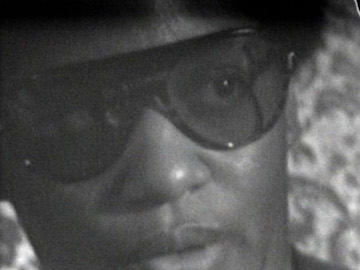
TVTV interviews feminist activist Margaret Sloan-Hunter at the National Women’s Political Caucus meeting during the 1972 Democratic National Convention.
The presence of citizen reporters with portable cameras was so new that Tricia Nixon expressed astonishment at the capability, and asked about the equipment. Says Campos-Quinn: “People weren’t used to that. It’s disarming to see these public figures talking more freely than they would, because now there’s an expectation that everything is going to be recorded.”
The TVTV crew, he adds, “got a little bit of grief, but not much. At the conventions they got the same access that any other reporters got. They had legitimate press passes.” Thanks in part to the sudden appearance of new means of capturing the news, “the notion of what a press operation was, at that point, was up in the air.”
They came away with footage of speeches and convention votes, but also backroom discussions, interactions with network television crews, and even a Newsweek reporter interviewing them.
the citizen journalism revolution
More than 30 pioneers of new media initiatives would take part in TVTV’s productions. The collective’s membership overlapped with that of other new media organizations such as Ant Farm and the Videofreex that in various ways brought about a sea-change in community-based news reporting and citizen journalism. By the time the collective began to dissipate or disperse, towards the late 1970s, several of its members were already on their way to impressive careers in media, whether in documentary filmmaking, video-based art, or other related fields.
Co-founder Michael Shamberg became a prolific Hollywood producer. His first wife and TVTV co-founder Megan Williams teaches at the University of Southern California and has become an Oscar-nominated producer of documentaries. Another co-founder, Chip Lord, and several others created the alternative media collective Ant Farm.
Figures like John Belushi and Bill Murray were tangentially involved before their prominent roles on Saturday Night Live and in films.
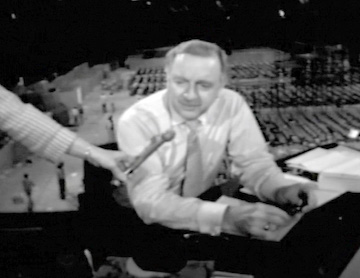
TVTV interviews a tired Walter Cronkite in the aftermath of the 1972 Democratic National Convention.
Not bad outcomes for a group Newsweek characterized as “braless, blue-jeaned video freaks.” That was a facile characterization, even then, Campos-Quinn suggests. For starters, it underestimates the concerted, self-aware goals of the collective, he says: “They really knew what they were doing. The main core of the group, in particular, weren’t just playing around with this stuff; they had a plan and were very well organized.”
In fact, he says, they all along planned on gaining national exposure. That was really inherent in what TVTV did, and set it apart from most other groups using Portapak-style technologies who gravitated towards community work, of its nature more localized.
Their determination and application to their goals also was apparent in how quickly and efficiently they edited their raw footage into broadcast-ready packages. At the two conventions, they shot about 150 half-hour tapes — 60 to 70 hours of footage, and “they managed to cut that down in the space of two weeks. They were learning, but they managed to get that done.”
A viewer today can see the improvement in how they went about their work by comparing their filming of the Democratic convention and the Republican one, just two weeks later. “They were better at choosing what to shoot,” says Campos-Quinn. And they were able to cut down to hour-long tapes in the space of a week or two.
The BAMPFA website will remain online indefinitely, but the current phase of the restoration project ends in June 2021.
The project is timely, in a variety of ways — not just due to the anxieties of the current political moment, but because the United States is in a period of reassessment of the cultural revolutions of the 1960s and ’70s — the Black Panthers, the hippies, the Yippies, the arts and music underground, other movements…
The BAMPFA exhibition is timely in another sense: the guerrilla TV innovators who captured such unprecedented images aren’t getting any younger. “The people who made these are in their 70s now, so in a few more years we won’t be able to interview them as effectively,” Campos-Quinn says. “They might not be in good health.”
Nor might the tapes. They are certain to deteriorate markedly, before too long. All, reports Campos-Quinn, had some degradation, especially the older ones. Half-inch open-reel tape is a format that was released in the late 1960s as one of the first portable videotape formats available to consumers. During the period TVTV was working, several iterations of tape stock came to market, and they improved over time, but the earliest TVTV tapes, from 1972, were in poor condition when the restoration project began, he says.
Some had been kept for many years in a damp basement in upstate New York, a hostile environment for tape. Others were scattered about in various parts of the country and were in better shape — more by happenstance than good planning, Campos-Quinn says.
Most of the tapes are not new to BAMPFA’s care — hundreds of hours of them came to the archive some 20 years ago. Now that grants have permitted restoration, along with presentation of sketches, snapshots, and documents from the time of the group’s reporting, BAMPFA has also set about interviewing TVTV personnel. Those will be placed on the Archive’s website, too.
The disruptions of COVID-19 have made it difficult to complete the tasks, Campos-Quinn says. Once the videos were transferred by by The MediaPreserve across the country near Pittsburgh, Pennsylvania, Campos-Quinn and his colleagues prepared them for display, working from their homes.
A key moment in the project will come on October 21 when, as part of its Out of the Vault series, BAMPFA will hold a program and screen the TVTV film of the Republican National Convention of 1972 — the finished work and some outtakes. A BAMPFA curator will hold a discussion with some of the original filmmakers.
The first two TVTV hour-long films, The World’s Largest TV Studio (about the DNC) and Four More Years (its RNC companion), which initially screened on cable channels and later via video distribution services, are now viewable online.
The TVTV project does not end there, says Campos-Quinn: “We have easily another thousand tapes from TVTV.” He and his colleagues hope that those will be digitized in the future.
And soon, says Campos-Quinn. The tapes are “just fundamentally unstable. We’re at the point now where the tapes are starting to degrade past the point of being able to play them.”
Previous Post: Digitizing the First Days of Public Access Television
Next Post: 47 Orphan Films To Be Preserved with Federal Grants





